Business Environment Report: Stakeholder Analysis of M&S & HSBC
VerifiedAdded on 2023/06/10
|12
|4259
|488
Report
AI Summary
This report provides a comprehensive analysis of the business environments of Marks & Spencer (M&S) and HSBC. It begins by examining the organizational type and market structure of Marks & Spencer, identifying it as a public limited company operating within an oligopolistic market. A stakeholder analysis of M&S follows, categorizing stakeholders based on their power and interest levels, including shareholders, government bodies, employees, customers, suppliers, and competitors. The report then shifts focus to HSBC, conducting a PESTEL analysis to evaluate the impact of political, economic, social, technological, environmental, and legal factors on the bank's operations. Additionally, Porter's Five Forces model is applied to assess the competitive intensity within the banking industry. The report concludes by evaluating HSBC's short-term and long-term performance, providing insights into its overall development. Desklib provides access to this and other solved assignments.
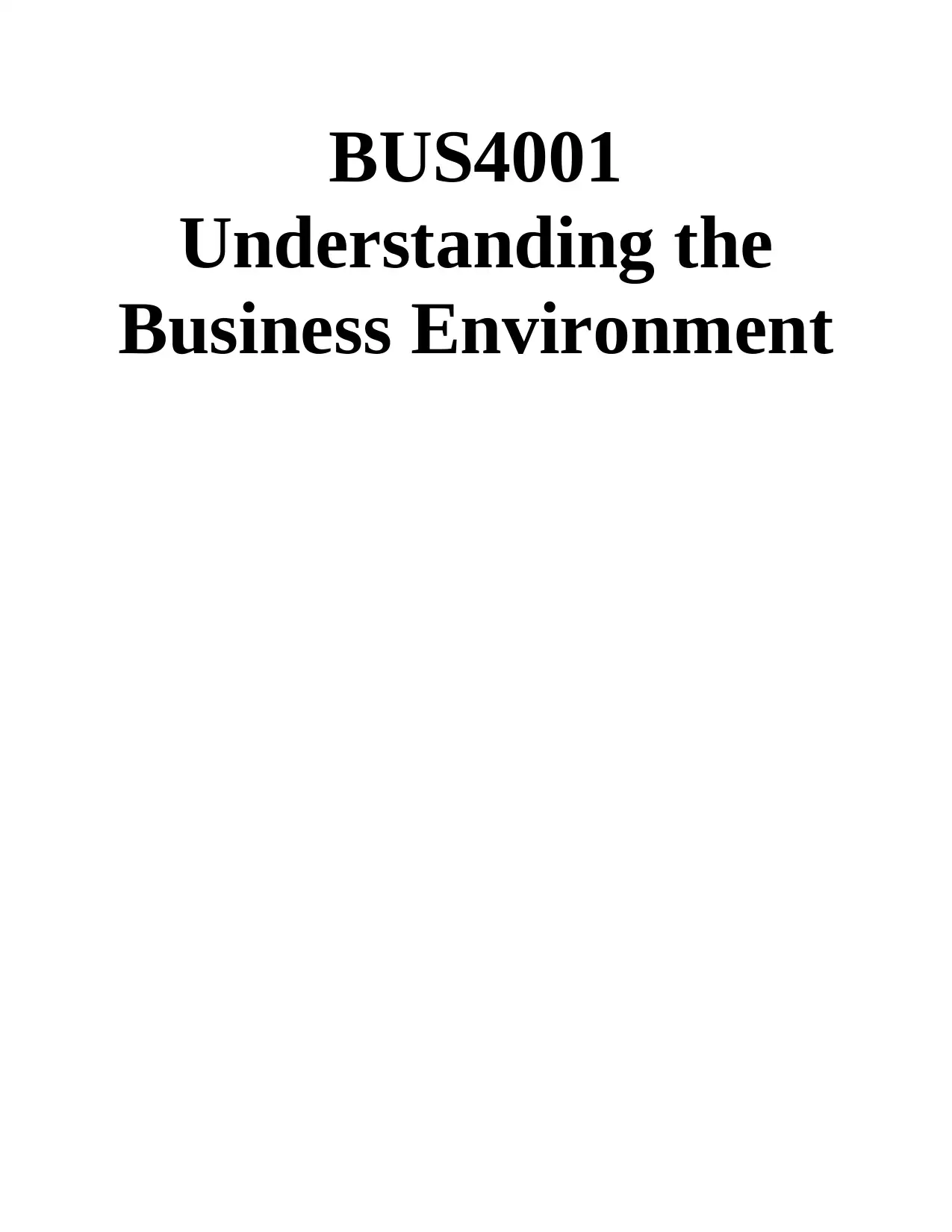
BUS4001
Understanding the
Business Environment
Understanding the
Business Environment
Paraphrase This Document
Need a fresh take? Get an instant paraphrase of this document with our AI Paraphraser
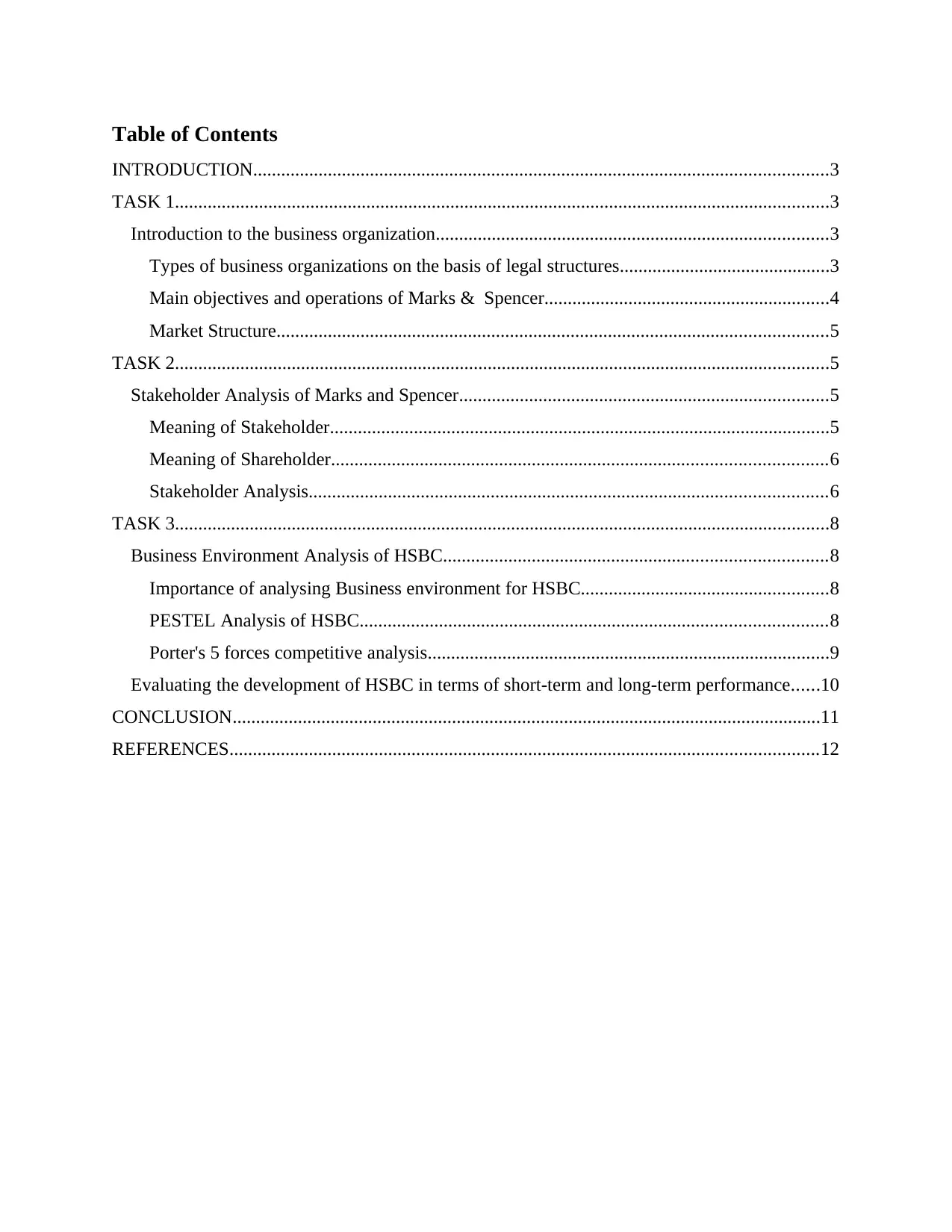
Table of Contents
INTRODUCTION...........................................................................................................................3
TASK 1............................................................................................................................................3
Introduction to the business organization....................................................................................3
Types of business organizations on the basis of legal structures.............................................3
Main objectives and operations of Marks & Spencer.............................................................4
Market Structure......................................................................................................................5
TASK 2............................................................................................................................................5
Stakeholder Analysis of Marks and Spencer...............................................................................5
Meaning of Stakeholder...........................................................................................................5
Meaning of Shareholder..........................................................................................................6
Stakeholder Analysis...............................................................................................................6
TASK 3............................................................................................................................................8
Business Environment Analysis of HSBC..................................................................................8
Importance of analysing Business environment for HSBC.....................................................8
PESTEL Analysis of HSBC....................................................................................................8
Porter's 5 forces competitive analysis......................................................................................9
Evaluating the development of HSBC in terms of short-term and long-term performance......10
CONCLUSION..............................................................................................................................11
REFERENCES..............................................................................................................................12
INTRODUCTION...........................................................................................................................3
TASK 1............................................................................................................................................3
Introduction to the business organization....................................................................................3
Types of business organizations on the basis of legal structures.............................................3
Main objectives and operations of Marks & Spencer.............................................................4
Market Structure......................................................................................................................5
TASK 2............................................................................................................................................5
Stakeholder Analysis of Marks and Spencer...............................................................................5
Meaning of Stakeholder...........................................................................................................5
Meaning of Shareholder..........................................................................................................6
Stakeholder Analysis...............................................................................................................6
TASK 3............................................................................................................................................8
Business Environment Analysis of HSBC..................................................................................8
Importance of analysing Business environment for HSBC.....................................................8
PESTEL Analysis of HSBC....................................................................................................8
Porter's 5 forces competitive analysis......................................................................................9
Evaluating the development of HSBC in terms of short-term and long-term performance......10
CONCLUSION..............................................................................................................................11
REFERENCES..............................................................................................................................12
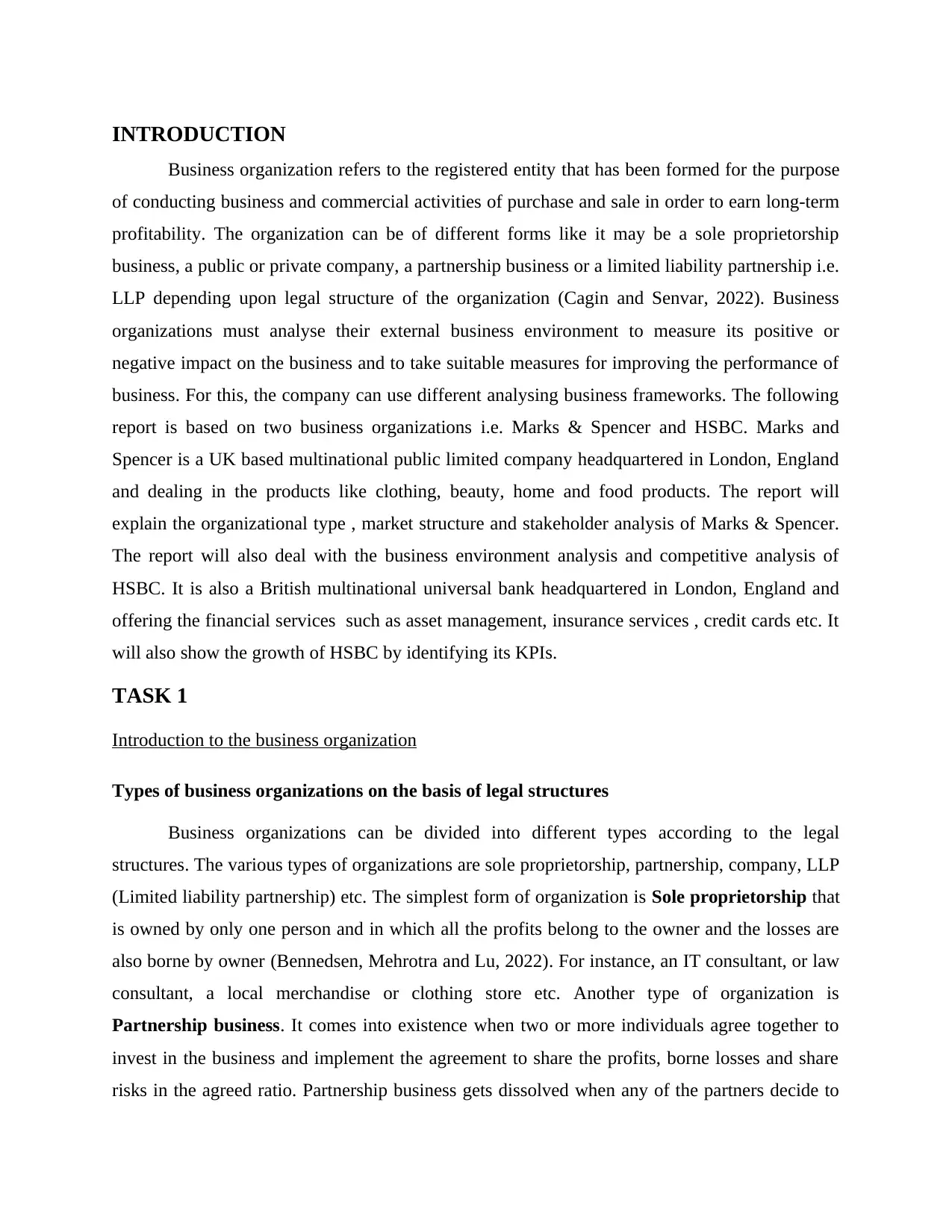
INTRODUCTION
Business organization refers to the registered entity that has been formed for the purpose
of conducting business and commercial activities of purchase and sale in order to earn long-term
profitability. The organization can be of different forms like it may be a sole proprietorship
business, a public or private company, a partnership business or a limited liability partnership i.e.
LLP depending upon legal structure of the organization (Cagin and Senvar, 2022). Business
organizations must analyse their external business environment to measure its positive or
negative impact on the business and to take suitable measures for improving the performance of
business. For this, the company can use different analysing business frameworks. The following
report is based on two business organizations i.e. Marks & Spencer and HSBC. Marks and
Spencer is a UK based multinational public limited company headquartered in London, England
and dealing in the products like clothing, beauty, home and food products. The report will
explain the organizational type , market structure and stakeholder analysis of Marks & Spencer.
The report will also deal with the business environment analysis and competitive analysis of
HSBC. It is also a British multinational universal bank headquartered in London, England and
offering the financial services such as asset management, insurance services , credit cards etc. It
will also show the growth of HSBC by identifying its KPIs.
TASK 1
Introduction to the business organization
Types of business organizations on the basis of legal structures
Business organizations can be divided into different types according to the legal
structures. The various types of organizations are sole proprietorship, partnership, company, LLP
(Limited liability partnership) etc. The simplest form of organization is Sole proprietorship that
is owned by only one person and in which all the profits belong to the owner and the losses are
also borne by owner (Bennedsen, Mehrotra and Lu, 2022). For instance, an IT consultant, or law
consultant, a local merchandise or clothing store etc. Another type of organization is
Partnership business. It comes into existence when two or more individuals agree together to
invest in the business and implement the agreement to share the profits, borne losses and share
risks in the agreed ratio. Partnership business gets dissolved when any of the partners decide to
Business organization refers to the registered entity that has been formed for the purpose
of conducting business and commercial activities of purchase and sale in order to earn long-term
profitability. The organization can be of different forms like it may be a sole proprietorship
business, a public or private company, a partnership business or a limited liability partnership i.e.
LLP depending upon legal structure of the organization (Cagin and Senvar, 2022). Business
organizations must analyse their external business environment to measure its positive or
negative impact on the business and to take suitable measures for improving the performance of
business. For this, the company can use different analysing business frameworks. The following
report is based on two business organizations i.e. Marks & Spencer and HSBC. Marks and
Spencer is a UK based multinational public limited company headquartered in London, England
and dealing in the products like clothing, beauty, home and food products. The report will
explain the organizational type , market structure and stakeholder analysis of Marks & Spencer.
The report will also deal with the business environment analysis and competitive analysis of
HSBC. It is also a British multinational universal bank headquartered in London, England and
offering the financial services such as asset management, insurance services , credit cards etc. It
will also show the growth of HSBC by identifying its KPIs.
TASK 1
Introduction to the business organization
Types of business organizations on the basis of legal structures
Business organizations can be divided into different types according to the legal
structures. The various types of organizations are sole proprietorship, partnership, company, LLP
(Limited liability partnership) etc. The simplest form of organization is Sole proprietorship that
is owned by only one person and in which all the profits belong to the owner and the losses are
also borne by owner (Bennedsen, Mehrotra and Lu, 2022). For instance, an IT consultant, or law
consultant, a local merchandise or clothing store etc. Another type of organization is
Partnership business. It comes into existence when two or more individuals agree together to
invest in the business and implement the agreement to share the profits, borne losses and share
risks in the agreed ratio. Partnership business gets dissolved when any of the partners decide to
⊘ This is a preview!⊘
Do you want full access?
Subscribe today to unlock all pages.

Trusted by 1+ million students worldwide
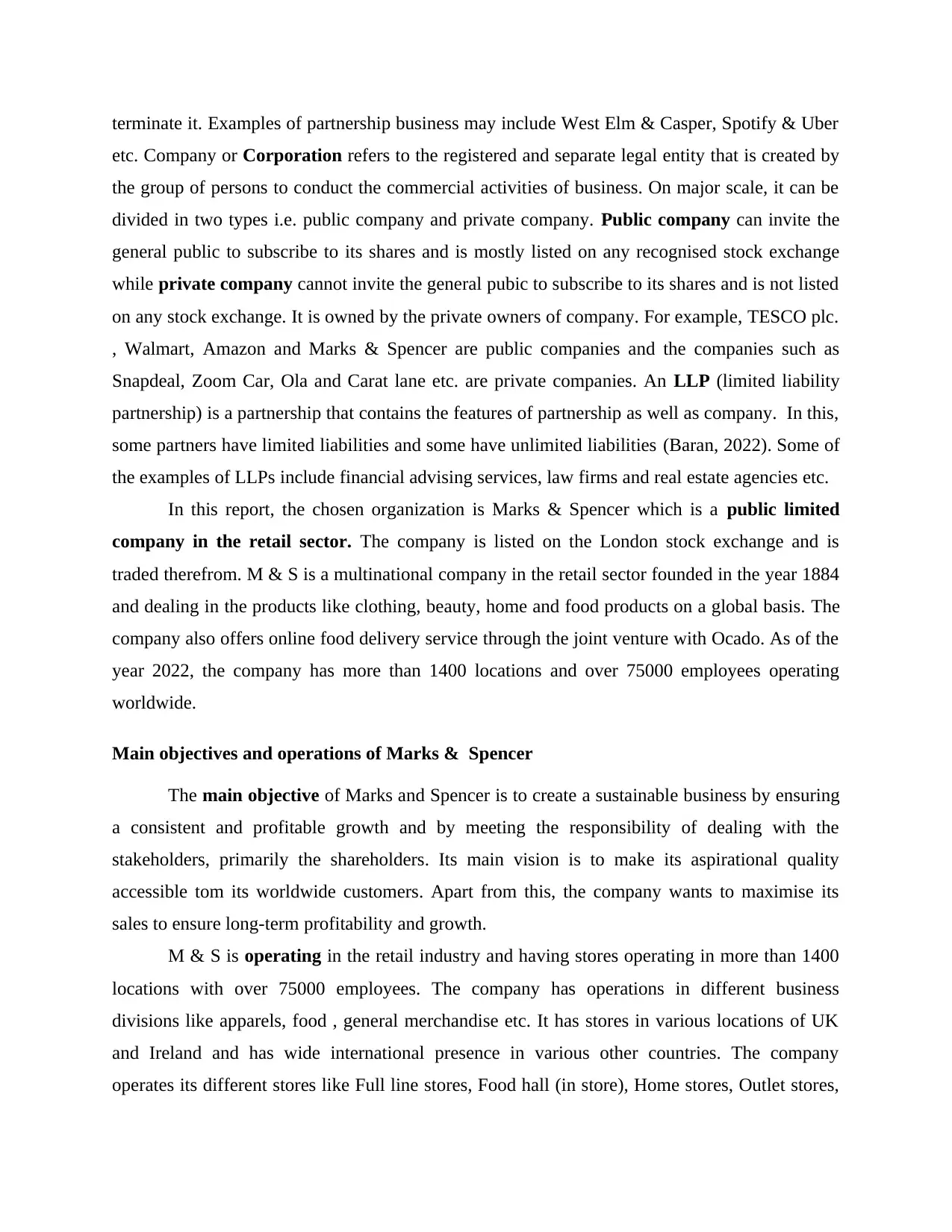
terminate it. Examples of partnership business may include West Elm & Casper, Spotify & Uber
etc. Company or Corporation refers to the registered and separate legal entity that is created by
the group of persons to conduct the commercial activities of business. On major scale, it can be
divided in two types i.e. public company and private company. Public company can invite the
general public to subscribe to its shares and is mostly listed on any recognised stock exchange
while private company cannot invite the general pubic to subscribe to its shares and is not listed
on any stock exchange. It is owned by the private owners of company. For example, TESCO plc.
, Walmart, Amazon and Marks & Spencer are public companies and the companies such as
Snapdeal, Zoom Car, Ola and Carat lane etc. are private companies. An LLP (limited liability
partnership) is a partnership that contains the features of partnership as well as company. In this,
some partners have limited liabilities and some have unlimited liabilities (Baran, 2022). Some of
the examples of LLPs include financial advising services, law firms and real estate agencies etc.
In this report, the chosen organization is Marks & Spencer which is a public limited
company in the retail sector. The company is listed on the London stock exchange and is
traded therefrom. M & S is a multinational company in the retail sector founded in the year 1884
and dealing in the products like clothing, beauty, home and food products on a global basis. The
company also offers online food delivery service through the joint venture with Ocado. As of the
year 2022, the company has more than 1400 locations and over 75000 employees operating
worldwide.
Main objectives and operations of Marks & Spencer
The main objective of Marks and Spencer is to create a sustainable business by ensuring
a consistent and profitable growth and by meeting the responsibility of dealing with the
stakeholders, primarily the shareholders. Its main vision is to make its aspirational quality
accessible tom its worldwide customers. Apart from this, the company wants to maximise its
sales to ensure long-term profitability and growth.
M & S is operating in the retail industry and having stores operating in more than 1400
locations with over 75000 employees. The company has operations in different business
divisions like apparels, food , general merchandise etc. It has stores in various locations of UK
and Ireland and has wide international presence in various other countries. The company
operates its different stores like Full line stores, Food hall (in store), Home stores, Outlet stores,
etc. Company or Corporation refers to the registered and separate legal entity that is created by
the group of persons to conduct the commercial activities of business. On major scale, it can be
divided in two types i.e. public company and private company. Public company can invite the
general public to subscribe to its shares and is mostly listed on any recognised stock exchange
while private company cannot invite the general pubic to subscribe to its shares and is not listed
on any stock exchange. It is owned by the private owners of company. For example, TESCO plc.
, Walmart, Amazon and Marks & Spencer are public companies and the companies such as
Snapdeal, Zoom Car, Ola and Carat lane etc. are private companies. An LLP (limited liability
partnership) is a partnership that contains the features of partnership as well as company. In this,
some partners have limited liabilities and some have unlimited liabilities (Baran, 2022). Some of
the examples of LLPs include financial advising services, law firms and real estate agencies etc.
In this report, the chosen organization is Marks & Spencer which is a public limited
company in the retail sector. The company is listed on the London stock exchange and is
traded therefrom. M & S is a multinational company in the retail sector founded in the year 1884
and dealing in the products like clothing, beauty, home and food products on a global basis. The
company also offers online food delivery service through the joint venture with Ocado. As of the
year 2022, the company has more than 1400 locations and over 75000 employees operating
worldwide.
Main objectives and operations of Marks & Spencer
The main objective of Marks and Spencer is to create a sustainable business by ensuring
a consistent and profitable growth and by meeting the responsibility of dealing with the
stakeholders, primarily the shareholders. Its main vision is to make its aspirational quality
accessible tom its worldwide customers. Apart from this, the company wants to maximise its
sales to ensure long-term profitability and growth.
M & S is operating in the retail industry and having stores operating in more than 1400
locations with over 75000 employees. The company has operations in different business
divisions like apparels, food , general merchandise etc. It has stores in various locations of UK
and Ireland and has wide international presence in various other countries. The company
operates its different stores like Full line stores, Food hall (in store), Home stores, Outlet stores,
Paraphrase This Document
Need a fresh take? Get an instant paraphrase of this document with our AI Paraphraser
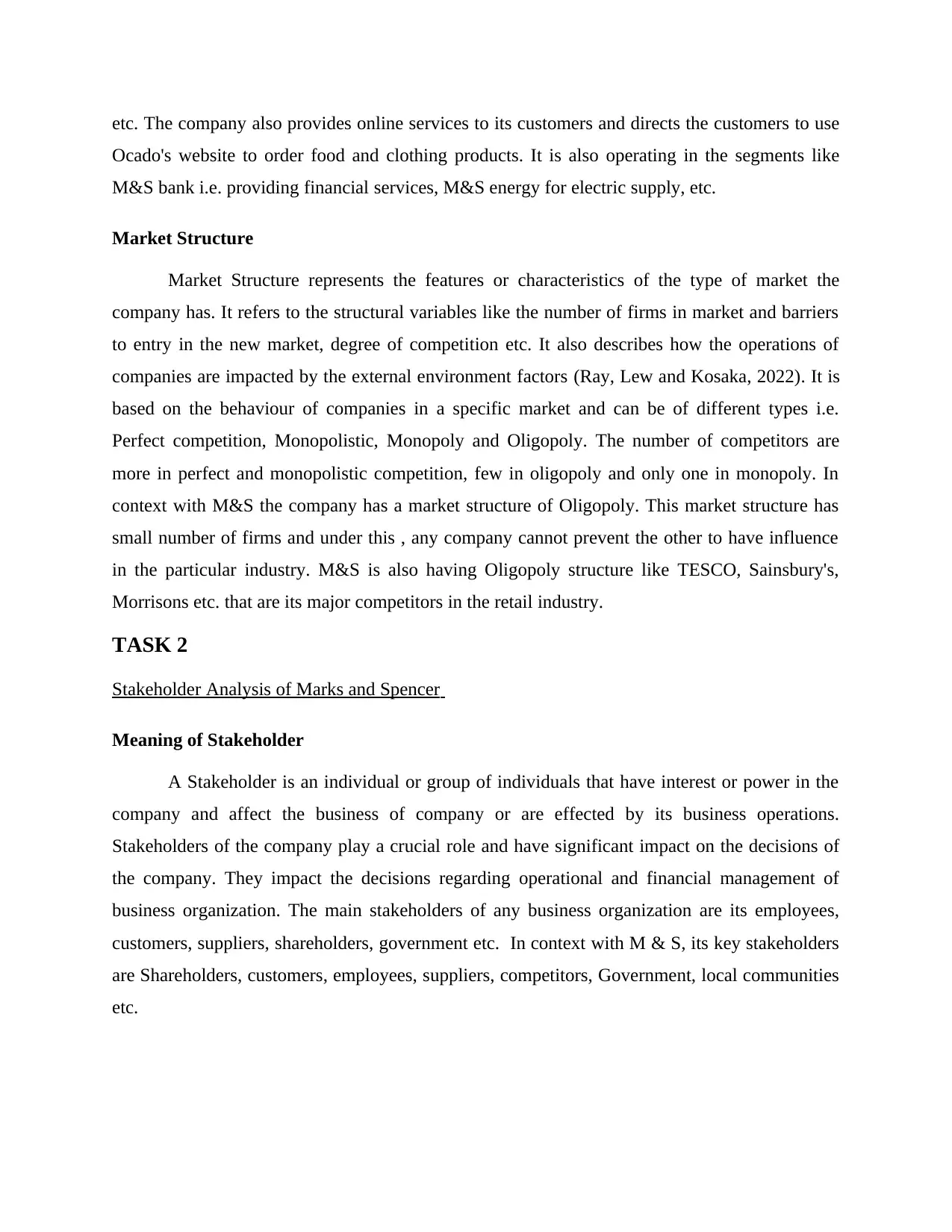
etc. The company also provides online services to its customers and directs the customers to use
Ocado's website to order food and clothing products. It is also operating in the segments like
M&S bank i.e. providing financial services, M&S energy for electric supply, etc.
Market Structure
Market Structure represents the features or characteristics of the type of market the
company has. It refers to the structural variables like the number of firms in market and barriers
to entry in the new market, degree of competition etc. It also describes how the operations of
companies are impacted by the external environment factors (Ray, Lew and Kosaka, 2022). It is
based on the behaviour of companies in a specific market and can be of different types i.e.
Perfect competition, Monopolistic, Monopoly and Oligopoly. The number of competitors are
more in perfect and monopolistic competition, few in oligopoly and only one in monopoly. In
context with M&S the company has a market structure of Oligopoly. This market structure has
small number of firms and under this , any company cannot prevent the other to have influence
in the particular industry. M&S is also having Oligopoly structure like TESCO, Sainsbury's,
Morrisons etc. that are its major competitors in the retail industry.
TASK 2
Stakeholder Analysis of Marks and Spencer
Meaning of Stakeholder
A Stakeholder is an individual or group of individuals that have interest or power in the
company and affect the business of company or are effected by its business operations.
Stakeholders of the company play a crucial role and have significant impact on the decisions of
the company. They impact the decisions regarding operational and financial management of
business organization. The main stakeholders of any business organization are its employees,
customers, suppliers, shareholders, government etc. In context with M & S, its key stakeholders
are Shareholders, customers, employees, suppliers, competitors, Government, local communities
etc.
Ocado's website to order food and clothing products. It is also operating in the segments like
M&S bank i.e. providing financial services, M&S energy for electric supply, etc.
Market Structure
Market Structure represents the features or characteristics of the type of market the
company has. It refers to the structural variables like the number of firms in market and barriers
to entry in the new market, degree of competition etc. It also describes how the operations of
companies are impacted by the external environment factors (Ray, Lew and Kosaka, 2022). It is
based on the behaviour of companies in a specific market and can be of different types i.e.
Perfect competition, Monopolistic, Monopoly and Oligopoly. The number of competitors are
more in perfect and monopolistic competition, few in oligopoly and only one in monopoly. In
context with M&S the company has a market structure of Oligopoly. This market structure has
small number of firms and under this , any company cannot prevent the other to have influence
in the particular industry. M&S is also having Oligopoly structure like TESCO, Sainsbury's,
Morrisons etc. that are its major competitors in the retail industry.
TASK 2
Stakeholder Analysis of Marks and Spencer
Meaning of Stakeholder
A Stakeholder is an individual or group of individuals that have interest or power in the
company and affect the business of company or are effected by its business operations.
Stakeholders of the company play a crucial role and have significant impact on the decisions of
the company. They impact the decisions regarding operational and financial management of
business organization. The main stakeholders of any business organization are its employees,
customers, suppliers, shareholders, government etc. In context with M & S, its key stakeholders
are Shareholders, customers, employees, suppliers, competitors, Government, local communities
etc.
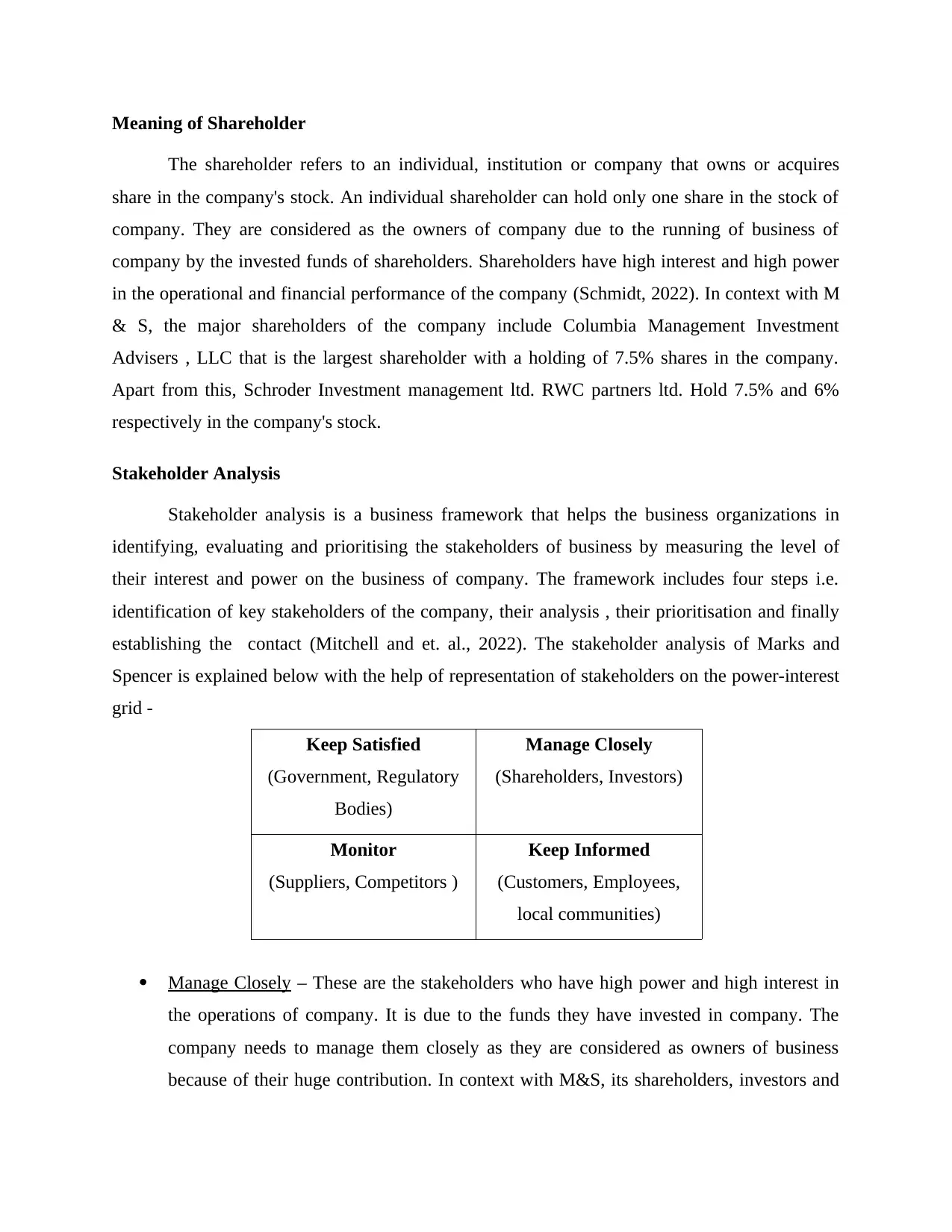
Meaning of Shareholder
The shareholder refers to an individual, institution or company that owns or acquires
share in the company's stock. An individual shareholder can hold only one share in the stock of
company. They are considered as the owners of company due to the running of business of
company by the invested funds of shareholders. Shareholders have high interest and high power
in the operational and financial performance of the company (Schmidt, 2022). In context with M
& S, the major shareholders of the company include Columbia Management Investment
Advisers , LLC that is the largest shareholder with a holding of 7.5% shares in the company.
Apart from this, Schroder Investment management ltd. RWC partners ltd. Hold 7.5% and 6%
respectively in the company's stock.
Stakeholder Analysis
Stakeholder analysis is a business framework that helps the business organizations in
identifying, evaluating and prioritising the stakeholders of business by measuring the level of
their interest and power on the business of company. The framework includes four steps i.e.
identification of key stakeholders of the company, their analysis , their prioritisation and finally
establishing the contact (Mitchell and et. al., 2022). The stakeholder analysis of Marks and
Spencer is explained below with the help of representation of stakeholders on the power-interest
grid -
Keep Satisfied
(Government, Regulatory
Bodies)
Manage Closely
(Shareholders, Investors)
Monitor
(Suppliers, Competitors )
Keep Informed
(Customers, Employees,
local communities)
Manage Closely – These are the stakeholders who have high power and high interest in
the operations of company. It is due to the funds they have invested in company. The
company needs to manage them closely as they are considered as owners of business
because of their huge contribution. In context with M&S, its shareholders, investors and
The shareholder refers to an individual, institution or company that owns or acquires
share in the company's stock. An individual shareholder can hold only one share in the stock of
company. They are considered as the owners of company due to the running of business of
company by the invested funds of shareholders. Shareholders have high interest and high power
in the operational and financial performance of the company (Schmidt, 2022). In context with M
& S, the major shareholders of the company include Columbia Management Investment
Advisers , LLC that is the largest shareholder with a holding of 7.5% shares in the company.
Apart from this, Schroder Investment management ltd. RWC partners ltd. Hold 7.5% and 6%
respectively in the company's stock.
Stakeholder Analysis
Stakeholder analysis is a business framework that helps the business organizations in
identifying, evaluating and prioritising the stakeholders of business by measuring the level of
their interest and power on the business of company. The framework includes four steps i.e.
identification of key stakeholders of the company, their analysis , their prioritisation and finally
establishing the contact (Mitchell and et. al., 2022). The stakeholder analysis of Marks and
Spencer is explained below with the help of representation of stakeholders on the power-interest
grid -
Keep Satisfied
(Government, Regulatory
Bodies)
Manage Closely
(Shareholders, Investors)
Monitor
(Suppliers, Competitors )
Keep Informed
(Customers, Employees,
local communities)
Manage Closely – These are the stakeholders who have high power and high interest in
the operations of company. It is due to the funds they have invested in company. The
company needs to manage them closely as they are considered as owners of business
because of their huge contribution. In context with M&S, its shareholders, investors and
⊘ This is a preview!⊘
Do you want full access?
Subscribe today to unlock all pages.

Trusted by 1+ million students worldwide
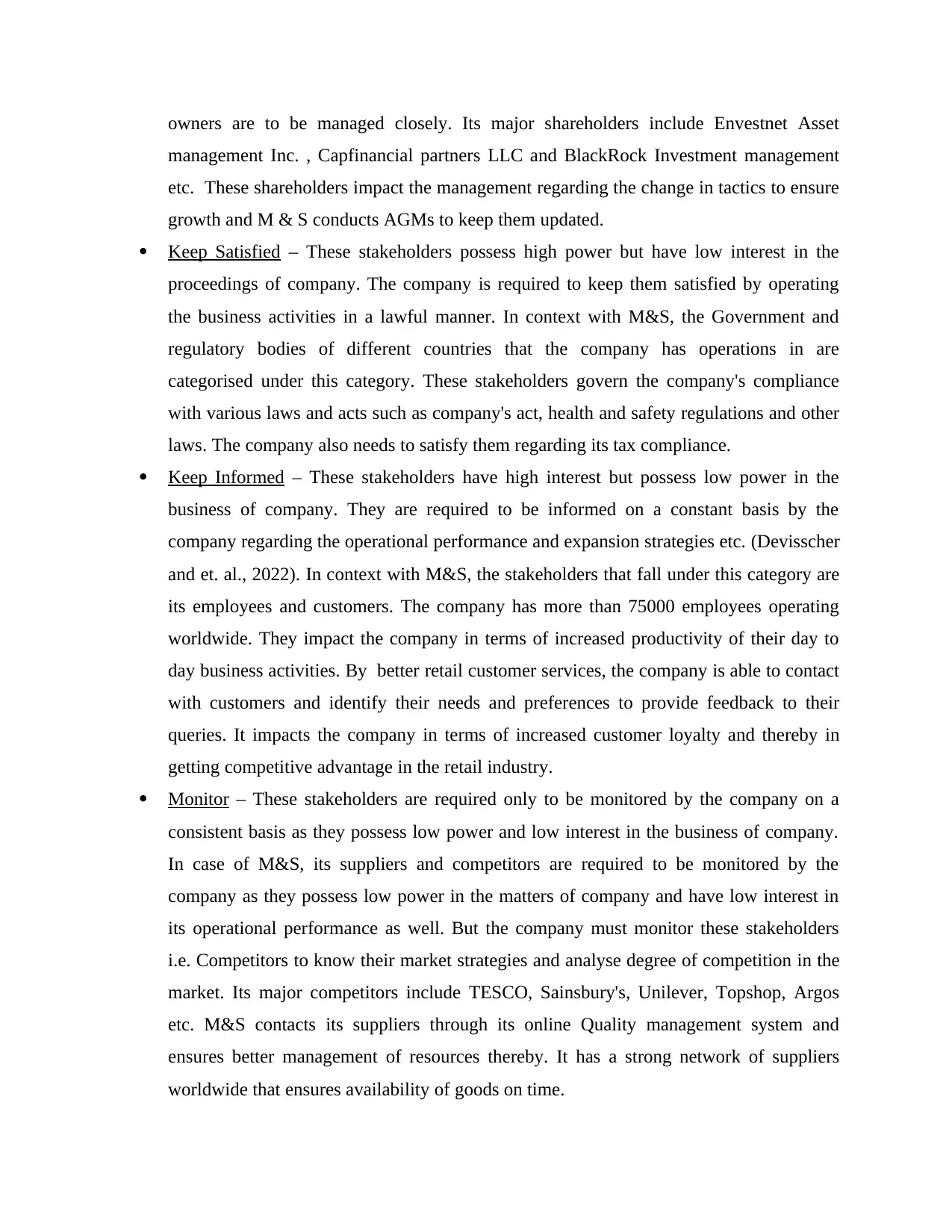
owners are to be managed closely. Its major shareholders include Envestnet Asset
management Inc. , Capfinancial partners LLC and BlackRock Investment management
etc. These shareholders impact the management regarding the change in tactics to ensure
growth and M & S conducts AGMs to keep them updated.
Keep Satisfied – These stakeholders possess high power but have low interest in the
proceedings of company. The company is required to keep them satisfied by operating
the business activities in a lawful manner. In context with M&S, the Government and
regulatory bodies of different countries that the company has operations in are
categorised under this category. These stakeholders govern the company's compliance
with various laws and acts such as company's act, health and safety regulations and other
laws. The company also needs to satisfy them regarding its tax compliance.
Keep Informed – These stakeholders have high interest but possess low power in the
business of company. They are required to be informed on a constant basis by the
company regarding the operational performance and expansion strategies etc. (Devisscher
and et. al., 2022). In context with M&S, the stakeholders that fall under this category are
its employees and customers. The company has more than 75000 employees operating
worldwide. They impact the company in terms of increased productivity of their day to
day business activities. By better retail customer services, the company is able to contact
with customers and identify their needs and preferences to provide feedback to their
queries. It impacts the company in terms of increased customer loyalty and thereby in
getting competitive advantage in the retail industry.
Monitor – These stakeholders are required only to be monitored by the company on a
consistent basis as they possess low power and low interest in the business of company.
In case of M&S, its suppliers and competitors are required to be monitored by the
company as they possess low power in the matters of company and have low interest in
its operational performance as well. But the company must monitor these stakeholders
i.e. Competitors to know their market strategies and analyse degree of competition in the
market. Its major competitors include TESCO, Sainsbury's, Unilever, Topshop, Argos
etc. M&S contacts its suppliers through its online Quality management system and
ensures better management of resources thereby. It has a strong network of suppliers
worldwide that ensures availability of goods on time.
management Inc. , Capfinancial partners LLC and BlackRock Investment management
etc. These shareholders impact the management regarding the change in tactics to ensure
growth and M & S conducts AGMs to keep them updated.
Keep Satisfied – These stakeholders possess high power but have low interest in the
proceedings of company. The company is required to keep them satisfied by operating
the business activities in a lawful manner. In context with M&S, the Government and
regulatory bodies of different countries that the company has operations in are
categorised under this category. These stakeholders govern the company's compliance
with various laws and acts such as company's act, health and safety regulations and other
laws. The company also needs to satisfy them regarding its tax compliance.
Keep Informed – These stakeholders have high interest but possess low power in the
business of company. They are required to be informed on a constant basis by the
company regarding the operational performance and expansion strategies etc. (Devisscher
and et. al., 2022). In context with M&S, the stakeholders that fall under this category are
its employees and customers. The company has more than 75000 employees operating
worldwide. They impact the company in terms of increased productivity of their day to
day business activities. By better retail customer services, the company is able to contact
with customers and identify their needs and preferences to provide feedback to their
queries. It impacts the company in terms of increased customer loyalty and thereby in
getting competitive advantage in the retail industry.
Monitor – These stakeholders are required only to be monitored by the company on a
consistent basis as they possess low power and low interest in the business of company.
In case of M&S, its suppliers and competitors are required to be monitored by the
company as they possess low power in the matters of company and have low interest in
its operational performance as well. But the company must monitor these stakeholders
i.e. Competitors to know their market strategies and analyse degree of competition in the
market. Its major competitors include TESCO, Sainsbury's, Unilever, Topshop, Argos
etc. M&S contacts its suppliers through its online Quality management system and
ensures better management of resources thereby. It has a strong network of suppliers
worldwide that ensures availability of goods on time.
Paraphrase This Document
Need a fresh take? Get an instant paraphrase of this document with our AI Paraphraser
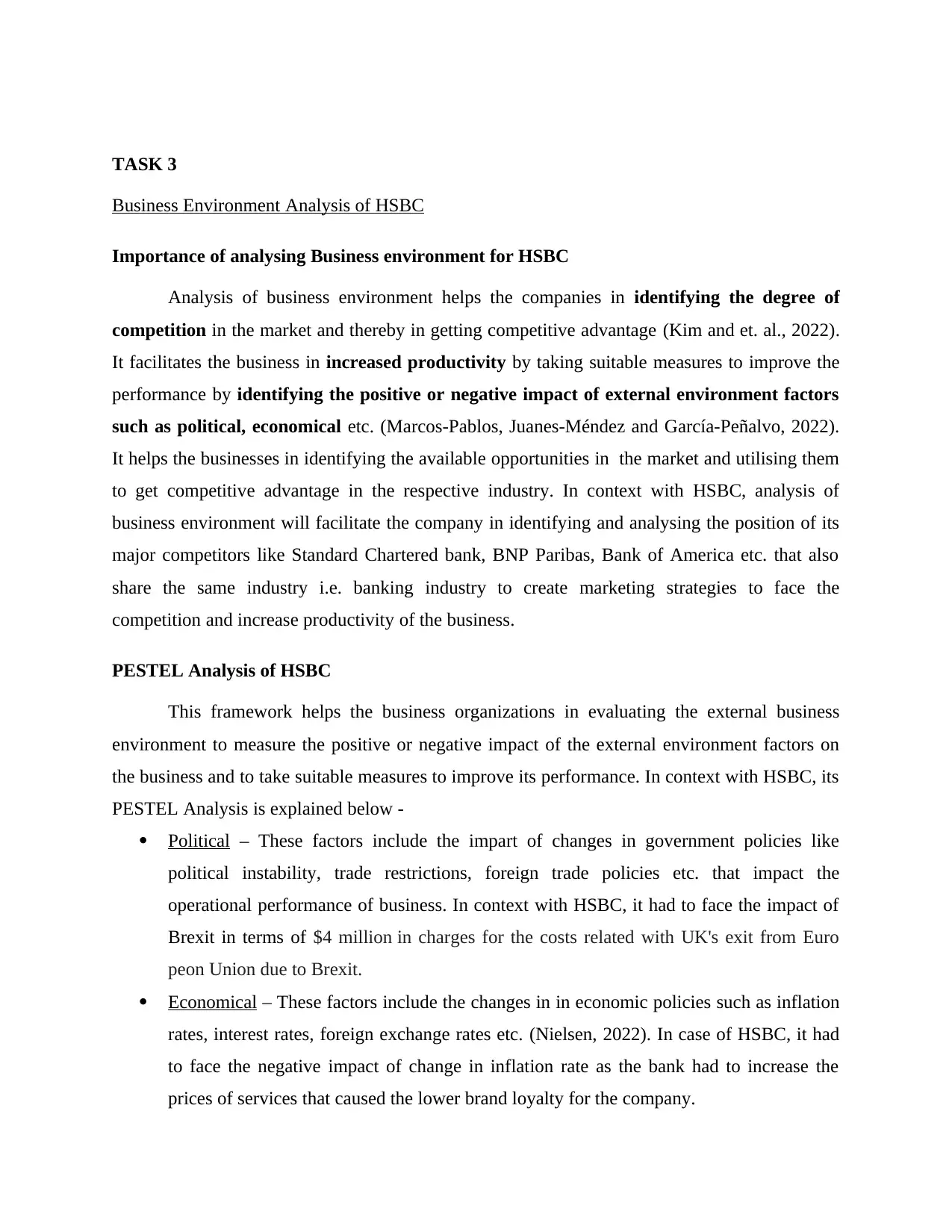
TASK 3
Business Environment Analysis of HSBC
Importance of analysing Business environment for HSBC
Analysis of business environment helps the companies in identifying the degree of
competition in the market and thereby in getting competitive advantage (Kim and et. al., 2022).
It facilitates the business in increased productivity by taking suitable measures to improve the
performance by identifying the positive or negative impact of external environment factors
such as political, economical etc. (Marcos-Pablos, Juanes-Méndez and García-Peñalvo, 2022).
It helps the businesses in identifying the available opportunities in the market and utilising them
to get competitive advantage in the respective industry. In context with HSBC, analysis of
business environment will facilitate the company in identifying and analysing the position of its
major competitors like Standard Chartered bank, BNP Paribas, Bank of America etc. that also
share the same industry i.e. banking industry to create marketing strategies to face the
competition and increase productivity of the business.
PESTEL Analysis of HSBC
This framework helps the business organizations in evaluating the external business
environment to measure the positive or negative impact of the external environment factors on
the business and to take suitable measures to improve its performance. In context with HSBC, its
PESTEL Analysis is explained below -
Political – These factors include the impart of changes in government policies like
political instability, trade restrictions, foreign trade policies etc. that impact the
operational performance of business. In context with HSBC, it had to face the impact of
Brexit in terms of $4 million in charges for the costs related with UK's exit from Euro
peon Union due to Brexit.
Economical – These factors include the changes in in economic policies such as inflation
rates, interest rates, foreign exchange rates etc. (Nielsen, 2022). In case of HSBC, it had
to face the negative impact of change in inflation rate as the bank had to increase the
prices of services that caused the lower brand loyalty for the company.
Business Environment Analysis of HSBC
Importance of analysing Business environment for HSBC
Analysis of business environment helps the companies in identifying the degree of
competition in the market and thereby in getting competitive advantage (Kim and et. al., 2022).
It facilitates the business in increased productivity by taking suitable measures to improve the
performance by identifying the positive or negative impact of external environment factors
such as political, economical etc. (Marcos-Pablos, Juanes-Méndez and García-Peñalvo, 2022).
It helps the businesses in identifying the available opportunities in the market and utilising them
to get competitive advantage in the respective industry. In context with HSBC, analysis of
business environment will facilitate the company in identifying and analysing the position of its
major competitors like Standard Chartered bank, BNP Paribas, Bank of America etc. that also
share the same industry i.e. banking industry to create marketing strategies to face the
competition and increase productivity of the business.
PESTEL Analysis of HSBC
This framework helps the business organizations in evaluating the external business
environment to measure the positive or negative impact of the external environment factors on
the business and to take suitable measures to improve its performance. In context with HSBC, its
PESTEL Analysis is explained below -
Political – These factors include the impart of changes in government policies like
political instability, trade restrictions, foreign trade policies etc. that impact the
operational performance of business. In context with HSBC, it had to face the impact of
Brexit in terms of $4 million in charges for the costs related with UK's exit from Euro
peon Union due to Brexit.
Economical – These factors include the changes in in economic policies such as inflation
rates, interest rates, foreign exchange rates etc. (Nielsen, 2022). In case of HSBC, it had
to face the negative impact of change in inflation rate as the bank had to increase the
prices of services that caused the lower brand loyalty for the company.
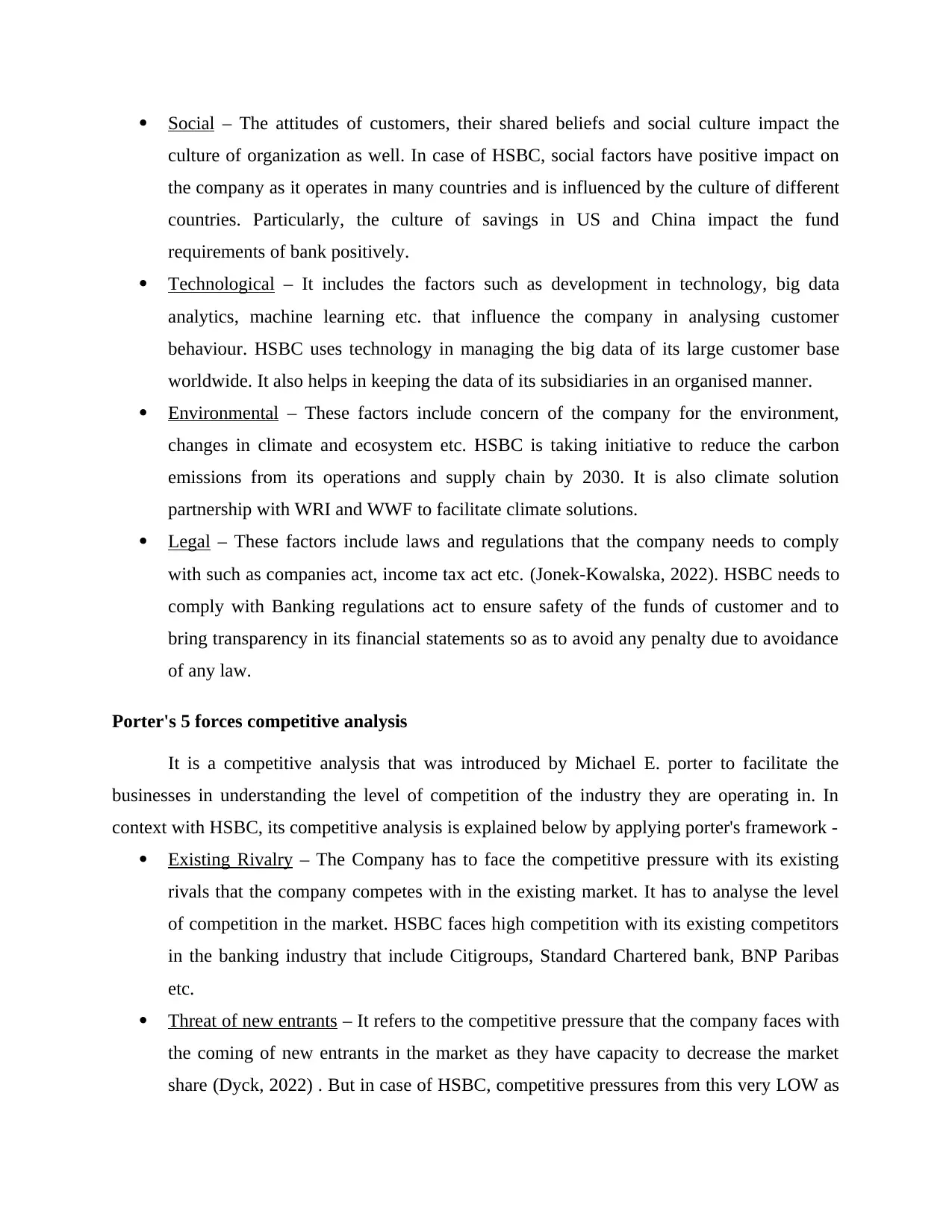
Social – The attitudes of customers, their shared beliefs and social culture impact the
culture of organization as well. In case of HSBC, social factors have positive impact on
the company as it operates in many countries and is influenced by the culture of different
countries. Particularly, the culture of savings in US and China impact the fund
requirements of bank positively.
Technological – It includes the factors such as development in technology, big data
analytics, machine learning etc. that influence the company in analysing customer
behaviour. HSBC uses technology in managing the big data of its large customer base
worldwide. It also helps in keeping the data of its subsidiaries in an organised manner.
Environmental – These factors include concern of the company for the environment,
changes in climate and ecosystem etc. HSBC is taking initiative to reduce the carbon
emissions from its operations and supply chain by 2030. It is also climate solution
partnership with WRI and WWF to facilitate climate solutions.
Legal – These factors include laws and regulations that the company needs to comply
with such as companies act, income tax act etc. (Jonek-Kowalska, 2022). HSBC needs to
comply with Banking regulations act to ensure safety of the funds of customer and to
bring transparency in its financial statements so as to avoid any penalty due to avoidance
of any law.
Porter's 5 forces competitive analysis
It is a competitive analysis that was introduced by Michael E. porter to facilitate the
businesses in understanding the level of competition of the industry they are operating in. In
context with HSBC, its competitive analysis is explained below by applying porter's framework -
Existing Rivalry – The Company has to face the competitive pressure with its existing
rivals that the company competes with in the existing market. It has to analyse the level
of competition in the market. HSBC faces high competition with its existing competitors
in the banking industry that include Citigroups, Standard Chartered bank, BNP Paribas
etc.
Threat of new entrants – It refers to the competitive pressure that the company faces with
the coming of new entrants in the market as they have capacity to decrease the market
share (Dyck, 2022) . But in case of HSBC, competitive pressures from this very LOW as
culture of organization as well. In case of HSBC, social factors have positive impact on
the company as it operates in many countries and is influenced by the culture of different
countries. Particularly, the culture of savings in US and China impact the fund
requirements of bank positively.
Technological – It includes the factors such as development in technology, big data
analytics, machine learning etc. that influence the company in analysing customer
behaviour. HSBC uses technology in managing the big data of its large customer base
worldwide. It also helps in keeping the data of its subsidiaries in an organised manner.
Environmental – These factors include concern of the company for the environment,
changes in climate and ecosystem etc. HSBC is taking initiative to reduce the carbon
emissions from its operations and supply chain by 2030. It is also climate solution
partnership with WRI and WWF to facilitate climate solutions.
Legal – These factors include laws and regulations that the company needs to comply
with such as companies act, income tax act etc. (Jonek-Kowalska, 2022). HSBC needs to
comply with Banking regulations act to ensure safety of the funds of customer and to
bring transparency in its financial statements so as to avoid any penalty due to avoidance
of any law.
Porter's 5 forces competitive analysis
It is a competitive analysis that was introduced by Michael E. porter to facilitate the
businesses in understanding the level of competition of the industry they are operating in. In
context with HSBC, its competitive analysis is explained below by applying porter's framework -
Existing Rivalry – The Company has to face the competitive pressure with its existing
rivals that the company competes with in the existing market. It has to analyse the level
of competition in the market. HSBC faces high competition with its existing competitors
in the banking industry that include Citigroups, Standard Chartered bank, BNP Paribas
etc.
Threat of new entrants – It refers to the competitive pressure that the company faces with
the coming of new entrants in the market as they have capacity to decrease the market
share (Dyck, 2022) . But in case of HSBC, competitive pressures from this very LOW as
⊘ This is a preview!⊘
Do you want full access?
Subscribe today to unlock all pages.

Trusted by 1+ million students worldwide
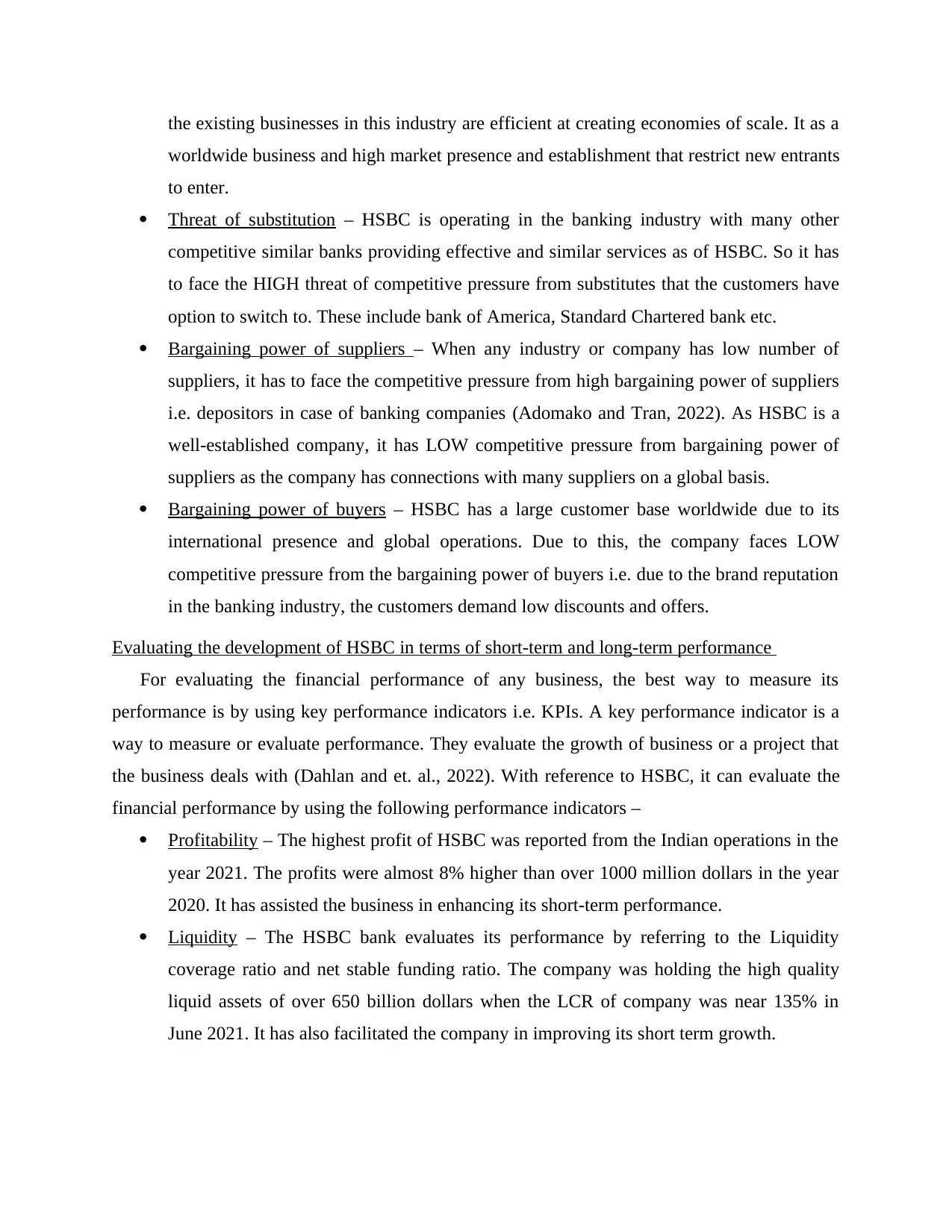
the existing businesses in this industry are efficient at creating economies of scale. It as a
worldwide business and high market presence and establishment that restrict new entrants
to enter.
Threat of substitution – HSBC is operating in the banking industry with many other
competitive similar banks providing effective and similar services as of HSBC. So it has
to face the HIGH threat of competitive pressure from substitutes that the customers have
option to switch to. These include bank of America, Standard Chartered bank etc.
Bargaining power of suppliers – When any industry or company has low number of
suppliers, it has to face the competitive pressure from high bargaining power of suppliers
i.e. depositors in case of banking companies (Adomako and Tran, 2022). As HSBC is a
well-established company, it has LOW competitive pressure from bargaining power of
suppliers as the company has connections with many suppliers on a global basis.
Bargaining power of buyers – HSBC has a large customer base worldwide due to its
international presence and global operations. Due to this, the company faces LOW
competitive pressure from the bargaining power of buyers i.e. due to the brand reputation
in the banking industry, the customers demand low discounts and offers.
Evaluating the development of HSBC in terms of short-term and long-term performance
For evaluating the financial performance of any business, the best way to measure its
performance is by using key performance indicators i.e. KPIs. A key performance indicator is a
way to measure or evaluate performance. They evaluate the growth of business or a project that
the business deals with (Dahlan and et. al., 2022). With reference to HSBC, it can evaluate the
financial performance by using the following performance indicators –
Profitability – The highest profit of HSBC was reported from the Indian operations in the
year 2021. The profits were almost 8% higher than over 1000 million dollars in the year
2020. It has assisted the business in enhancing its short-term performance.
Liquidity – The HSBC bank evaluates its performance by referring to the Liquidity
coverage ratio and net stable funding ratio. The company was holding the high quality
liquid assets of over 650 billion dollars when the LCR of company was near 135% in
June 2021. It has also facilitated the company in improving its short term growth.
worldwide business and high market presence and establishment that restrict new entrants
to enter.
Threat of substitution – HSBC is operating in the banking industry with many other
competitive similar banks providing effective and similar services as of HSBC. So it has
to face the HIGH threat of competitive pressure from substitutes that the customers have
option to switch to. These include bank of America, Standard Chartered bank etc.
Bargaining power of suppliers – When any industry or company has low number of
suppliers, it has to face the competitive pressure from high bargaining power of suppliers
i.e. depositors in case of banking companies (Adomako and Tran, 2022). As HSBC is a
well-established company, it has LOW competitive pressure from bargaining power of
suppliers as the company has connections with many suppliers on a global basis.
Bargaining power of buyers – HSBC has a large customer base worldwide due to its
international presence and global operations. Due to this, the company faces LOW
competitive pressure from the bargaining power of buyers i.e. due to the brand reputation
in the banking industry, the customers demand low discounts and offers.
Evaluating the development of HSBC in terms of short-term and long-term performance
For evaluating the financial performance of any business, the best way to measure its
performance is by using key performance indicators i.e. KPIs. A key performance indicator is a
way to measure or evaluate performance. They evaluate the growth of business or a project that
the business deals with (Dahlan and et. al., 2022). With reference to HSBC, it can evaluate the
financial performance by using the following performance indicators –
Profitability – The highest profit of HSBC was reported from the Indian operations in the
year 2021. The profits were almost 8% higher than over 1000 million dollars in the year
2020. It has assisted the business in enhancing its short-term performance.
Liquidity – The HSBC bank evaluates its performance by referring to the Liquidity
coverage ratio and net stable funding ratio. The company was holding the high quality
liquid assets of over 650 billion dollars when the LCR of company was near 135% in
June 2021. It has also facilitated the company in improving its short term growth.
Paraphrase This Document
Need a fresh take? Get an instant paraphrase of this document with our AI Paraphraser
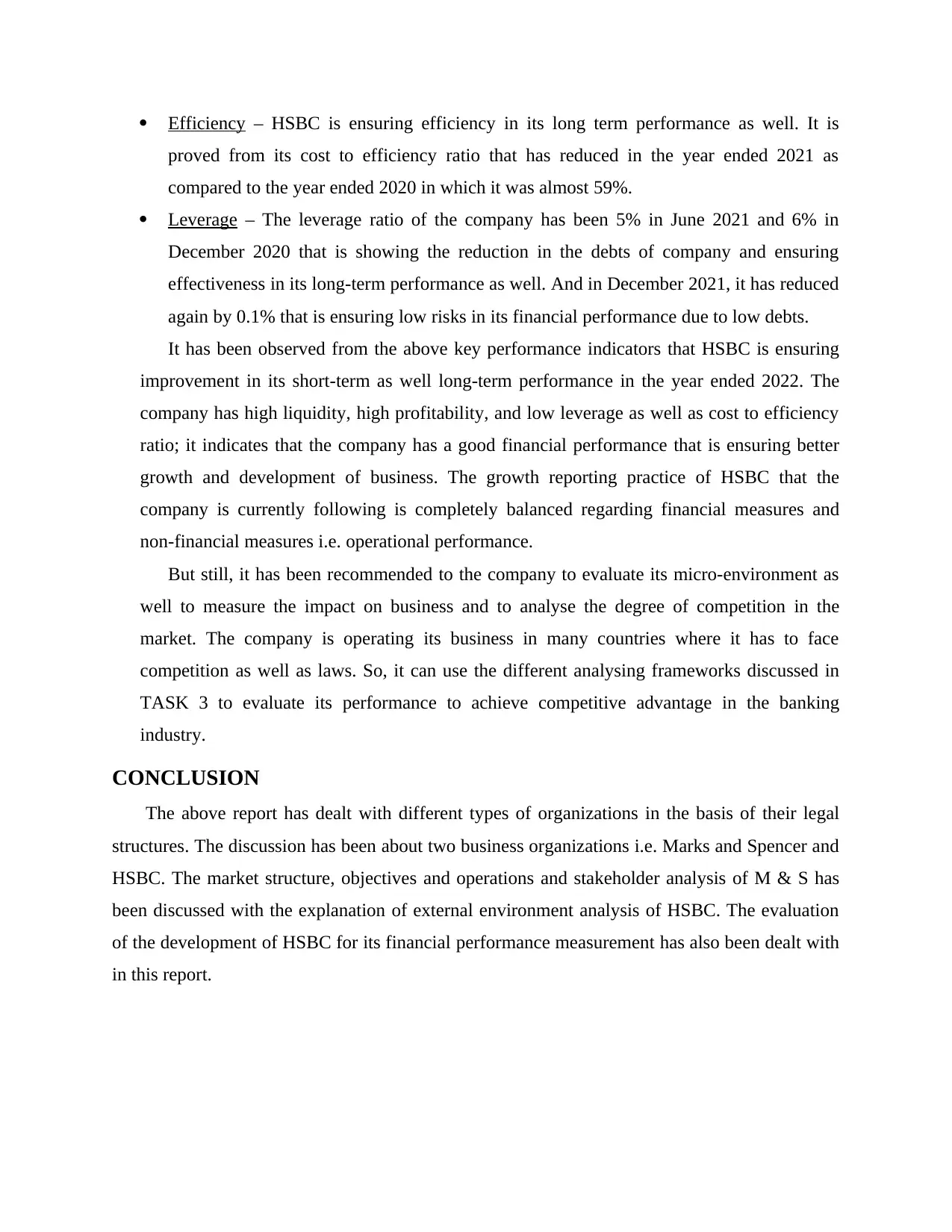
Efficiency – HSBC is ensuring efficiency in its long term performance as well. It is
proved from its cost to efficiency ratio that has reduced in the year ended 2021 as
compared to the year ended 2020 in which it was almost 59%.
Leverage – The leverage ratio of the company has been 5% in June 2021 and 6% in
December 2020 that is showing the reduction in the debts of company and ensuring
effectiveness in its long-term performance as well. And in December 2021, it has reduced
again by 0.1% that is ensuring low risks in its financial performance due to low debts.
It has been observed from the above key performance indicators that HSBC is ensuring
improvement in its short-term as well long-term performance in the year ended 2022. The
company has high liquidity, high profitability, and low leverage as well as cost to efficiency
ratio; it indicates that the company has a good financial performance that is ensuring better
growth and development of business. The growth reporting practice of HSBC that the
company is currently following is completely balanced regarding financial measures and
non-financial measures i.e. operational performance.
But still, it has been recommended to the company to evaluate its micro-environment as
well to measure the impact on business and to analyse the degree of competition in the
market. The company is operating its business in many countries where it has to face
competition as well as laws. So, it can use the different analysing frameworks discussed in
TASK 3 to evaluate its performance to achieve competitive advantage in the banking
industry.
CONCLUSION
The above report has dealt with different types of organizations in the basis of their legal
structures. The discussion has been about two business organizations i.e. Marks and Spencer and
HSBC. The market structure, objectives and operations and stakeholder analysis of M & S has
been discussed with the explanation of external environment analysis of HSBC. The evaluation
of the development of HSBC for its financial performance measurement has also been dealt with
in this report.
proved from its cost to efficiency ratio that has reduced in the year ended 2021 as
compared to the year ended 2020 in which it was almost 59%.
Leverage – The leverage ratio of the company has been 5% in June 2021 and 6% in
December 2020 that is showing the reduction in the debts of company and ensuring
effectiveness in its long-term performance as well. And in December 2021, it has reduced
again by 0.1% that is ensuring low risks in its financial performance due to low debts.
It has been observed from the above key performance indicators that HSBC is ensuring
improvement in its short-term as well long-term performance in the year ended 2022. The
company has high liquidity, high profitability, and low leverage as well as cost to efficiency
ratio; it indicates that the company has a good financial performance that is ensuring better
growth and development of business. The growth reporting practice of HSBC that the
company is currently following is completely balanced regarding financial measures and
non-financial measures i.e. operational performance.
But still, it has been recommended to the company to evaluate its micro-environment as
well to measure the impact on business and to analyse the degree of competition in the
market. The company is operating its business in many countries where it has to face
competition as well as laws. So, it can use the different analysing frameworks discussed in
TASK 3 to evaluate its performance to achieve competitive advantage in the banking
industry.
CONCLUSION
The above report has dealt with different types of organizations in the basis of their legal
structures. The discussion has been about two business organizations i.e. Marks and Spencer and
HSBC. The market structure, objectives and operations and stakeholder analysis of M & S has
been discussed with the explanation of external environment analysis of HSBC. The evaluation
of the development of HSBC for its financial performance measurement has also been dealt with
in this report.
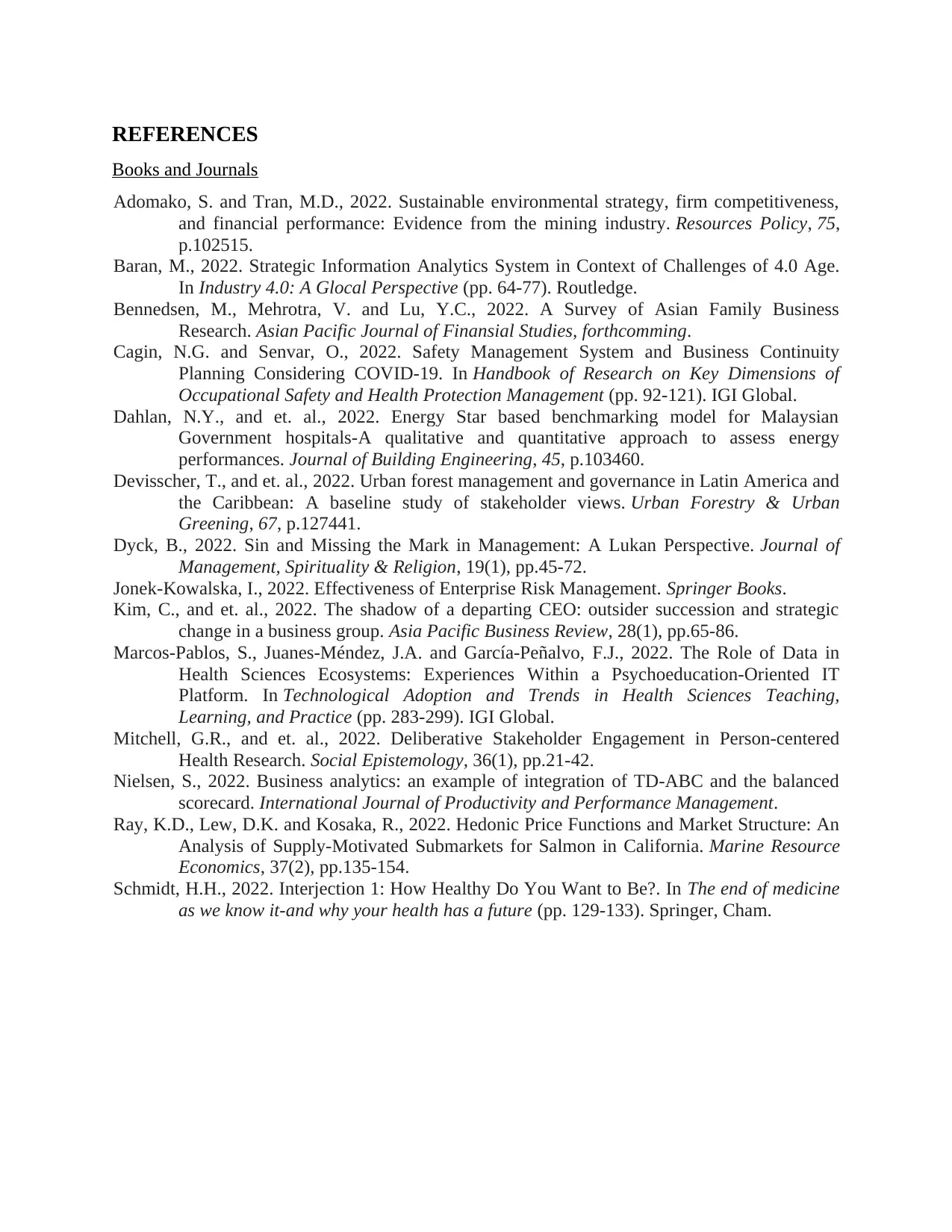
REFERENCES
Books and Journals
Adomako, S. and Tran, M.D., 2022. Sustainable environmental strategy, firm competitiveness,
and financial performance: Evidence from the mining industry. Resources Policy, 75,
p.102515.
Baran, M., 2022. Strategic Information Analytics System in Context of Challenges of 4.0 Age.
In Industry 4.0: A Glocal Perspective (pp. 64-77). Routledge.
Bennedsen, M., Mehrotra, V. and Lu, Y.C., 2022. A Survey of Asian Family Business
Research. Asian Pacific Journal of Finansial Studies, forthcomming.
Cagin, N.G. and Senvar, O., 2022. Safety Management System and Business Continuity
Planning Considering COVID-19. In Handbook of Research on Key Dimensions of
Occupational Safety and Health Protection Management (pp. 92-121). IGI Global.
Dahlan, N.Y., and et. al., 2022. Energy Star based benchmarking model for Malaysian
Government hospitals-A qualitative and quantitative approach to assess energy
performances. Journal of Building Engineering, 45, p.103460.
Devisscher, T., and et. al., 2022. Urban forest management and governance in Latin America and
the Caribbean: A baseline study of stakeholder views. Urban Forestry & Urban
Greening, 67, p.127441.
Dyck, B., 2022. Sin and Missing the Mark in Management: A Lukan Perspective. Journal of
Management, Spirituality & Religion, 19(1), pp.45-72.
Jonek-Kowalska, I., 2022. Effectiveness of Enterprise Risk Management. Springer Books.
Kim, C., and et. al., 2022. The shadow of a departing CEO: outsider succession and strategic
change in a business group. Asia Pacific Business Review, 28(1), pp.65-86.
Marcos-Pablos, S., Juanes-Méndez, J.A. and García-Peñalvo, F.J., 2022. The Role of Data in
Health Sciences Ecosystems: Experiences Within a Psychoeducation-Oriented IT
Platform. In Technological Adoption and Trends in Health Sciences Teaching,
Learning, and Practice (pp. 283-299). IGI Global.
Mitchell, G.R., and et. al., 2022. Deliberative Stakeholder Engagement in Person-centered
Health Research. Social Epistemology, 36(1), pp.21-42.
Nielsen, S., 2022. Business analytics: an example of integration of TD-ABC and the balanced
scorecard. International Journal of Productivity and Performance Management.
Ray, K.D., Lew, D.K. and Kosaka, R., 2022. Hedonic Price Functions and Market Structure: An
Analysis of Supply-Motivated Submarkets for Salmon in California. Marine Resource
Economics, 37(2), pp.135-154.
Schmidt, H.H., 2022. Interjection 1: How Healthy Do You Want to Be?. In The end of medicine
as we know it-and why your health has a future (pp. 129-133). Springer, Cham.
Books and Journals
Adomako, S. and Tran, M.D., 2022. Sustainable environmental strategy, firm competitiveness,
and financial performance: Evidence from the mining industry. Resources Policy, 75,
p.102515.
Baran, M., 2022. Strategic Information Analytics System in Context of Challenges of 4.0 Age.
In Industry 4.0: A Glocal Perspective (pp. 64-77). Routledge.
Bennedsen, M., Mehrotra, V. and Lu, Y.C., 2022. A Survey of Asian Family Business
Research. Asian Pacific Journal of Finansial Studies, forthcomming.
Cagin, N.G. and Senvar, O., 2022. Safety Management System and Business Continuity
Planning Considering COVID-19. In Handbook of Research on Key Dimensions of
Occupational Safety and Health Protection Management (pp. 92-121). IGI Global.
Dahlan, N.Y., and et. al., 2022. Energy Star based benchmarking model for Malaysian
Government hospitals-A qualitative and quantitative approach to assess energy
performances. Journal of Building Engineering, 45, p.103460.
Devisscher, T., and et. al., 2022. Urban forest management and governance in Latin America and
the Caribbean: A baseline study of stakeholder views. Urban Forestry & Urban
Greening, 67, p.127441.
Dyck, B., 2022. Sin and Missing the Mark in Management: A Lukan Perspective. Journal of
Management, Spirituality & Religion, 19(1), pp.45-72.
Jonek-Kowalska, I., 2022. Effectiveness of Enterprise Risk Management. Springer Books.
Kim, C., and et. al., 2022. The shadow of a departing CEO: outsider succession and strategic
change in a business group. Asia Pacific Business Review, 28(1), pp.65-86.
Marcos-Pablos, S., Juanes-Méndez, J.A. and García-Peñalvo, F.J., 2022. The Role of Data in
Health Sciences Ecosystems: Experiences Within a Psychoeducation-Oriented IT
Platform. In Technological Adoption and Trends in Health Sciences Teaching,
Learning, and Practice (pp. 283-299). IGI Global.
Mitchell, G.R., and et. al., 2022. Deliberative Stakeholder Engagement in Person-centered
Health Research. Social Epistemology, 36(1), pp.21-42.
Nielsen, S., 2022. Business analytics: an example of integration of TD-ABC and the balanced
scorecard. International Journal of Productivity and Performance Management.
Ray, K.D., Lew, D.K. and Kosaka, R., 2022. Hedonic Price Functions and Market Structure: An
Analysis of Supply-Motivated Submarkets for Salmon in California. Marine Resource
Economics, 37(2), pp.135-154.
Schmidt, H.H., 2022. Interjection 1: How Healthy Do You Want to Be?. In The end of medicine
as we know it-and why your health has a future (pp. 129-133). Springer, Cham.
⊘ This is a preview!⊘
Do you want full access?
Subscribe today to unlock all pages.

Trusted by 1+ million students worldwide
1 out of 12
Related Documents
Your All-in-One AI-Powered Toolkit for Academic Success.
+13062052269
info@desklib.com
Available 24*7 on WhatsApp / Email
![[object Object]](/_next/static/media/star-bottom.7253800d.svg)
Unlock your academic potential
Copyright © 2020–2025 A2Z Services. All Rights Reserved. Developed and managed by ZUCOL.





